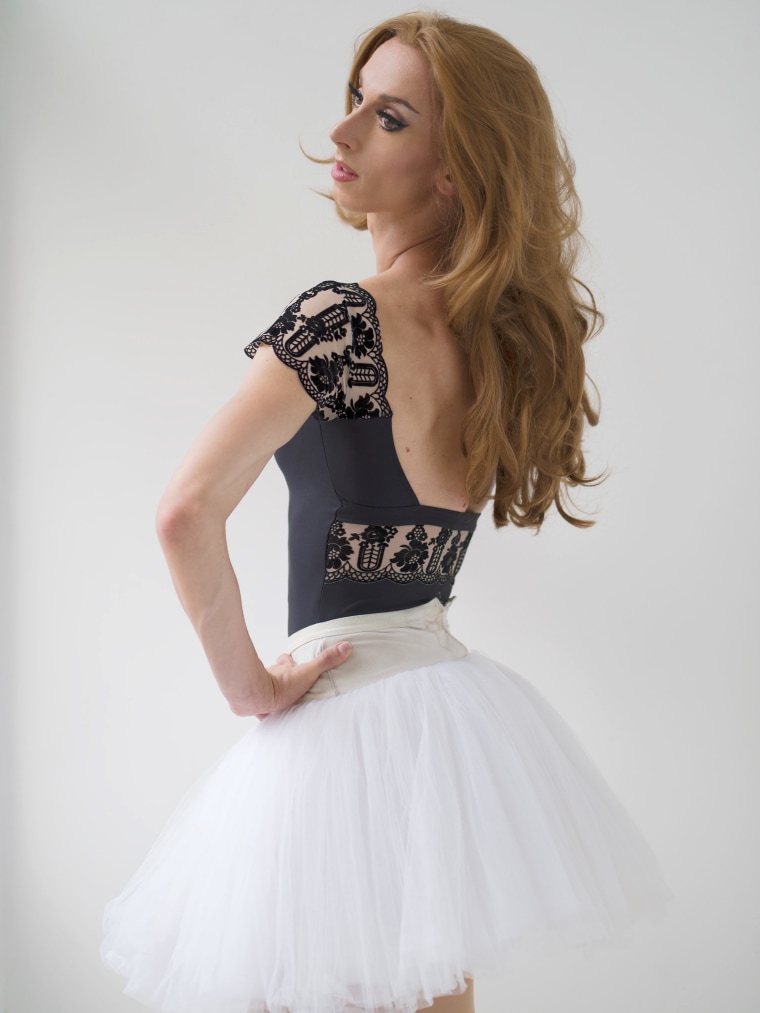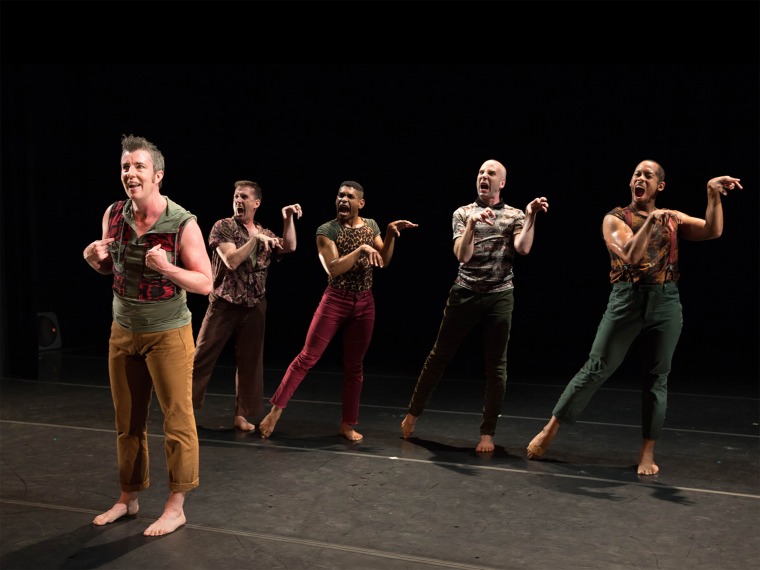Sean Dorsey was tired of being the only transgender dancer in the room. So he took the bold step of starting his own company, the San Francisco-based Sean Dorsey Dance, and become the first openly trans director of a full-time dance company. It was a milestone for transgender and gender-nonconforming dancers and choreographers, and Dorsey hoped it would lead to a more inclusive dance world.
"I wanted to have a career, and that slowed down my decision to transition."
Alby Sabrina Pretto
The company is celebrating its 15th anniversary this year, yet Dorsey remains the only openly trans artistic director of a full-time dance company in the country.
“We’ve definitely made progress since I started, when there was really no context for institutional or social support of trans dancers,” Dorsey said. “But there’s still a major lack of representation across the dance world.”
Dance, especially older forms such as ballet and modern dance, is mostly structured around strict gender lines. While the growing acceptance of transgender people in the United States has extended somewhat into the art form, trans dancers are often forced to choose between being their authentic selves and career opportunities.
Issues start in training
Dorsey’s choreography often deals with trans issues, and he is committed to being an advocate in the dance world for transgender people. But even in his own company, Dorsey is the only trans performer.
“In San Francisco, at least, I don’t have the luxury of holding an audition for trans dancers,” he said. “There just aren’t very many at the professional level.”
Dorsey said this is largely because barriers for trans and gender-nonconforming dancers start at a young age — as most training programs are gender-specific.
Jayna Ledford, 19, made headlines when she came out as transgender in an Instagram post in 2018. She was studying at the Kirov Ballet Academy at the time, a traditional ballet program in Washington, D.C. It was the first time a dancer at an acclaimed ballet school had publicly come out as trans.
Classes at Kirov, like most ballet conservatories, are generally separated by sex assigned at birth, and when students are combined, teachers offer different steps for men and women. Ledford, however, found ways to get the training that matched her gender identity, including dancing on her toes in special pointe shoes, which is done almost exclusively by women and requires unique training.
“I wanted to do what the females were doing,” she said. “I’d do it on the side and not pay attention to what the guys were doing. I’d also stay after class and practice pointe technique with my female friends.”
She hadn’t had the training other females at the school had, but she was hoping to transfer from the men’s program to the women’s.
“I knew I had a lot of catching up to do in terms of pointe work,” she said. “But just being in the room with the females, that’s what I wanted.”
The Kirov Academy told Ledford she could not join the women’s program unless she physically transitioned. Ledford was not ready for that, so she left the school. She was disappointed but now says she understands the academy’s position. The school confirmed Ledford’s account but declined to comment.
Maxfield Haynes, 22, who is nonbinary and uses they/them pronouns, said the large, prestigious ballet school where they trained was not supportive of someone presenting as male wearing pointe shoes.
It wasn’t until Haynes enrolled at Tisch School of the Arts at New York University that they were able to explore the more feminine aspects of ballet technique. Ledford also found higher education to be more supportive than a conservatory. She now studies at Montclair State University and practices pointe technique daily.
Lack of professional opportunities
After NYU, Haynes chose to dance with Complexions Contemporary Ballet partially because the company is explicitly supportive of gender fluidity, and even had a specific role for Haynes that is gender-nonconforming. In the David Bowie tribute piece, “Stardust,” Haynes dons pointe shoes and was partnered with male dancers.
“It was everything I could have dreamed of,” Haynes said of the role. “As nonbinary, I like to get to show all aspects of gender. I don’t think about dancing like a man or a woman, just myself.”
Opportunities to dance roles that are gender-nonconforming are rare in the concert dance world, even if dancers are becoming more open about being gender-nonconforming in their offstage lives. And those who want to physically transition face a stark choice, as none of the major dance companies in the U.S. currently have openly transgender dancers on their rosters.

Alby Sabrina Pretto recently made the difficult choice to begin physically transitioning with hormone replacement therapy at the expense of her performing career. She was a dancer with Les Ballet Trockadero de Monte Carlo, an all-male comedy troupe, for eight years. While she got to dance in pointe shoes, the style of the company is rooted in the comedy of men portraying women, which ultimately wasn’t how Pretto identified.
“There were moments I wanted to do things like a ballerina would and be ethereal and pretty,” Pretto said. “To dance like a woman.”
She knew that physically transitioning would mean she could not continue with the company.
“I wanted to have a career, and that slowed down my decision to transition,” Pretto said. “I waited until I felt like I had done what I wanted to do there.”
Liz Harler, general manager of Les Ballet Trockadero, said in a statement that transitioning does not disqualify dancers from the company.
“Dancers who expressed interest in transitioning to female have been told that their job would not be in jeopardy, though none have chosen to do so while continuing with the Trocks’ rigorous dancing and touring schedule,” Harler said.
Both Ledford and Pretto hope for the day when they can attend an audition and be hired without having to explain their gender identity.
Ledford said. “I’ll audition as any other woman. If I get in, then I’ll sit down and talk with them.”
Ledford is “optimistic” that this can happen in the next few years, but Pretto isn’t so sure.
“I am not naive, I know I cannot just audition for a major ballet company and join the female corps de ballet,” Pretto said. “But I would love for that to happen for me. It’s the ultimate dream.”
Her skepticism is partly based on the experience of her former Trockadero colleague, Chase Johnsey, who is gender fluid. He made headlines in 2018 when he was cast in a female ensemble role in the English National Ballet’s production of “Sleeping Beauty,” though it was not on pointe, and the heavy costume concealed his body. No additional female roles came his way afterward.
The question of who gets opportunities as a dancer often comes down to the taste of directors and producers and what they imagine their audiences want to see, not just ability.
Pretto danced a couple of character roles recently with Eglevsky Ballet, a growing ballet ensemble on Long Island, New York. The director, Maurice Brandon Curry, said he would consider Pretto for a female ensemble role next year, because her pointe work is “excellent,” though he wonders how some in the audience will react.
“Casting Alby in a female role would not be about passing as female, but I’d be lying if I didn’t acknowledge my concern about an audience member who was offended,” Curry said. “But art is not prejudice; it’s about inclusivity and open minds. If someone is not willing to have that experience, they don’t have a legitimate place in our audiences.”
Signs of change
Dorsey said that even having discussions about gender identity in dance is progress from when he started, and he’s encouraged by changes he’s seen: Most theaters either already have gender-neutral restrooms or create them for his company’s visit; trans and gender-nonconforming students attend his workshops in various cities and share with him their efforts to be accepted in their dance communities; the San Francisco Ballet persuaded him to lead a training session on gender identity in dance; and he was on the cover of Dance Magazine.
Ledford was recently a “Gaynor Girl,” a spokesperson for the popular pointe shoe brand Gaynor Minded. Pretto said she worked up the courage to use the ladies' locker room at one of New York’s busiest studios, Steps on Broadway, and no one seemed to mind.
Still, the art form has not yet caught up to reflect the audience, Dorsey said. His company has worked in over 30 cities in the U.S. and abroad, and he is usually the first trans choreographer a theater has presented. But he said the response from audiences is almost always positive.
“Dance audiences are ready and hungry for trans voices,” he said. “It's our dance institutions that are still catching up.”


